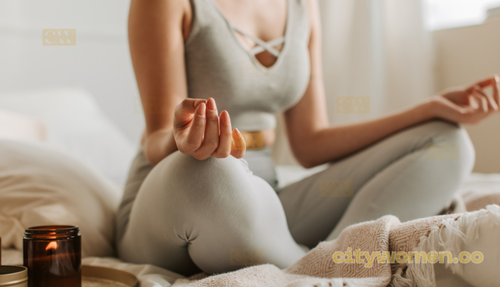
I was on the acupuncture table, face up, while my doctor pushed with both hands on the side of my stomach. “Oh wow,” he said. “You’re holding a lot of grief.” That’s strange, I thought. I wasn’t sad, and I hadn’t cried in recent memory. In fact, I was in a new relationship with someone I was very excited about, had just started a job I loved, and was finally looking for an apartment.
Sure, I had packed up my Los Angeles one-bedroom and moved home to New York during a global pandemic, mainly to be with my 98-year-old grandfather who was sick. And yes, moving back after eight years did trigger some culture shock (being 3,000 miles away from family and then being with family nearly every hour of every day can be jarring). And okay, dating again after ending a near-decade long relationship, I guess was kind of a big deal. But I was over all of that. I was handling it, and moving forward.
So there I was on the table. “Grief is stored in the stomach,” my doctor explained. “Got it,” I replied, hoping my deep skepticism didn’t come through, though it definitely did. See, I’m an a la carte-style wellness girlie. Yes to acupuncture, green powder, lymphatic massages, clean deodorants, and hot yoga (so long as the class has good music). But when my acupuncturist told me that he could feel grief in my stomach, I brushed it off. But two hours after my session, I was in my boyfriend’s apartment sobbing.
My body was once my instrument, my pen, and my paintbrush. In high school I danced ballet 36 hours a week. I know the power of expression through the body, without words. I sculpted my muscles and trusted them to remember the things I couldn’t. Somewhere along the way, I lost trust with my body and disconnected from it in some ways. But somatic yoga helped me bridge the gap.
What is somatic yoga, anyway?
Somatic yoga has become popular lately, with somatic simply meaning “as it relates to the body, especially as distinct from the mind,” per the Oxford English Dictionary. Somatic yoga flows usually consist of yoga poses you’re already familiar with—like child’s pose or happy baby pose—aimed at being more aware of what’s going on in your body and mind. In a sense, all yoga is somatic.
“We’re practicing holding our attention on what we’re doing throughout the entire practice,” Lisa Tatham Flynn, a New York City-based teacher certified in Hanna Somatic Education and trauma-informed yoga therapy, previously told Well+Good. “It’s a first-person, internal, lived-experience practice.”
Does somatic yoga work? My experience with the practice
When my mother called me at 8 a.m. last January to tell me that my grandfather had died, I tried to get up from my bed but I couldn’t stand. A searing pain shot from my lower back, radiating down my leg and through my entire being. I crawled on the floor next to my bed, and sat there in a haze, confused as to why my back was giving out. “It’s grief,” a family friend told me. “Grief is held in the body.” “No, I think it’s because I’ve been sleeping weird and plus, I’ve been lifting grandpa every day for the last few weeks. It’ll go away on its own,” I replied.
For the next month I hobbled, shuddered when I made a wrong move, pursed my lips in pain, and dismissed my sisters’ pleas for me to see a doctor. The physical pain was a distraction from the agonizing torture of losing my best friend. My entire being was racked with the malaise of grief I couldn’t escape—and I was desperate for relief.
The grief would creep up on me, never fully subsiding, its hand constantly on my neck. My therapist had suggested gentle movement and diaphragmatic breathing. Finally ready to take her advice, during yet another restless sleepless night, I searched for “emotional release yoga” on YouTube and found a 20-minute hip opening video by yoga teacher Caitlin K’eli, E-RYT 500. I put my iPad on my bed, and followed along right from my mattress in my pajamas. This is definitely not going to work, I thought, throughout the session. And then, 18 minutes in, during happy baby pose, the tears rushed out of the corners of my eyes into my sheets.
“Angry people live in angry bodies,” writes Bessel van der Kolk in his book The Body Keeps the Score. “Physical self-awareness is the first step in releasing the tyranny of the past.” The first time I cried in a yoga class was in 2015 during Savasana at a 6:30 a.m. Hot8 Yoga Barre class in Santa Monica. But K’eli’s videos helped me see what there is to be gained when the music is turned off, phone put away, and there isn’t a 20-rep sequence of pulsing and crunching coming up. To stretch, to be gentle, to be aware of my breath, to release.
Each of K’eli’s videos range from 10 to 30 minutes. I started doing them in bed in my pajamas, because that’s what I could do. Now, I’ll do some in bed and roll out the yoga mat when that feels like the right move. Slowly, I’m re-building my relationship with my body. We’re building trust, and I’m learning to listen. For me, the release usually comes in a pose toward the end. What surfaces isn’t always about the same thing, usually it’s something unexpected—a realization, an epiphany, and ultimately, relief. A few sessions ago, I pressed play thinking I wanted respite from the grief of death. Afterward, I found myself calling my boyfriend to tell him how much I love him.
“The greatest sources of our suffering are the lies we tell ourselves,” says van der Kolk. I am fine, when I’m not. I am over it, when I’m still in it. That doesn’t hurt, when it does. What’s so liberating about an emotional release is its pure honesty. To know thyself is the greatest gift we can give ourselves. All you need is the courage to set yourself free.










